Graphite Nanoplatelets Nanostructured Films as Multifunctional Protective Layer in Kevlar/Nomex Sandwich Composites
Abstract
:Featured Application
Abstract
1. Introduction
2. Materials and Methods
2.1. Materials and Manufacturing Procedure
- (i)
- Stacking of the lower skin according to the layout sequence (0/90)4.
- (ii)
- Core positioning, where the core was prepared according to the final geometry before lamination.
- (iii)
- Stacking by prepregs the core contour (0/90)6 and the upper skin (0/90)4.
- (iv)
- Curing in an oven for 2 h at 120 °C in a vacuum bag.
2.2. Experimental Characterization
3. Results
3.1. GNPs-Protective Coating Functional Properties
3.2. Moisture Diffusion in Sandwich Plates
4. Discussion
4.1. Influence of Filler Content on Water Uptake
4.2. Ground-Air-Ground (GAG)
- Parking the aircraft on the ground in a cool environment: lower the chamber temperature to −54 C° at a rate of 5 °C/min and keep these conditions for 45 min.
- Lowering the chamber pressure to 120 mbar with a minimum temperature of −54 °C. This condition represents the take-off up to 15,000 m with a maximum ascent rate. Keep these conditions for 40 min.
- Increase the pressure to 1013 mbar and raise the temperature to 70 °C simulating landing in a warm environment and parking on the ground at 70 °C for 25 min.
- Increase relative humidity to 95% and remain in this condition (70 °C and RH 95%) for 60 min (park on the ground in a hot, humid environment).
- Return chamber conditions to 20 °C and 50% and remain for 10 min.
4.3. Non-Destructive Inspection of Sandwich Plates
5. Conclusions
Author Contributions
Funding
Institutional Review Board Statement
Informed Consent Statement
Data Availability Statement
Acknowledgments
Conflicts of Interest
References
- Soutis, C. Carbon fiber reinforced plastics in aircraft construction. Mater. Sci. Eng. A 2005, 412, 171–176. [Google Scholar] [CrossRef]
- Hahn, H.T.; Kim, K.S. Hygroscopic Effects in Aramid Fiber/Epoxy Composite. J. Eng. Mater. Technol. 1988, 110, 153–157. [Google Scholar] [CrossRef]
- Xiao, G.Z.; Shanahan, M.E.R. Water absorption and desorption in an epoxy resin with degradation. J. Polym. Sci. Part B Polym. Phys. 1997, 35, 2659–2670. [Google Scholar] [CrossRef]
- Wan, Y.Z.; Wang, Y.L.; Huang, Y.; Luo, H.L.; He, F.; Chen, G.C. Moisture absorption in a three-dimensional braided carbon/Kevlar/epoxy hybrid composite for orthopaedic usage and its influence on mechanical performance. Compos. Part A Appl. Sci. Manuf. 2006, 37, 1480–1484. [Google Scholar] [CrossRef]
- Eckstein, B.H. Moisture absorption by epoxy laminating resins. Org. Coat. Plast. Chem. 1978, 38, 503–509. [Google Scholar]
- Olmos, D.; López-Morón, R.; González-Benito, J. The nature of the glass fibre surface and its effect in the water absorption of glass fibre/epoxy composites. The use of fluorescence to obtain information at the interface. Compos. Sci. Technol. 2006, 66, 2758–2768. [Google Scholar] [CrossRef]
- Velmurugan, G.; Natrayan, L. Experimental investigations of moisture diffusion and mechanical properties of interply rearrangement of glass/Kevlar-based hybrid composites under cryogenic environment. J. Mater. Res. Technol. 2023, 23, 4513–4526. [Google Scholar] [CrossRef]
- Verpoest, I.; Springer, G.S. Moisture Absorption Characteristics of Aramid-Epoxy Composites. J. Reinf. Plast. Compos. 1988, 7, 2–22. [Google Scholar] [CrossRef]
- Gopalan, R.; Rao, R.M.V.G.K.; Murthy, M.V.V.; Dattaguru, B. Diffusion Studies on Advanced Fibre Hybrid Composites. J. Reinf. Plast. Compos. 1986, 5, 51–61. [Google Scholar] [CrossRef]
- McKague, E.L., Jr.; Reynolds, J.D.; Halkias, J.E. Swelling and glass transition relations for epoxy matrix material in humid environments. J. Appl. Polym. Sci. 1978, 22, 1643–1654. [Google Scholar] [CrossRef]
- Mijović, J.; Lin, K. The effect of hygrothermal fatigue on physical/mechanical properties and morphology of neat epoxy resin and graphite/epoxy composite. J. Appl. Polym. Sci. 1985, 30, 2527–2549. [Google Scholar] [CrossRef]
- Xiao, G.Z.; Shanahan, M.E.R. Swelling of DGEBA/DDA epoxy resin during hygrothermal ageing. Polymer 1998, 39, 3253–3260. [Google Scholar] [CrossRef]
- Yahaya, R.; Sapuan, S.M.; Jawaid, M.; Leman, Z.; Zainudin, E.S. Water absorption behaviour and impact strength of Kenaf-Kevlar reinforced epoxy hybrid composites. Adv. Compos. Lett. 2016, 25, 98–102. [Google Scholar] [CrossRef]
- Yeung, K.K.H.; Rao, K.P. Mechanical Properties of Kevlar-49 Fibre Reinforced Thermoplastic Composites. Polym. Polym. Compos. 2012, 20, 411–424. [Google Scholar] [CrossRef]
- Cise, D.; Lakes, R.S. Moisture ingression in honeycomb core sandwich panels. J. Mater. Eng. Perform. 1997, 6, 732–736. [Google Scholar] [CrossRef]
- Shafizadeh, J.E.; Seferis, J.C.; Chesmar, E.F.; Frye, B.A.; Geyer, R. Evaluation of the mechanisms of water migration through honeycomb core. J. Mater. Sci. 2003, 38, 2547–2555. [Google Scholar] [CrossRef]
- Glass, D.E.; Raman, V.V.; Venkat, V.S.; Sankaran, S.N. Honeycomb Core Permeability under Mechanical Loads; No. NASA/CR-97-206263; NASA: Washington, DC, USA, 1997. [Google Scholar]
- Choi, H.S.; Jang, Y.H. Bondline strength evaluation of cocure/precured honeycomb sandwich structures under aircraft hygro and repair environments. Compos. Part A Appl. Sci. Manuf. 2010, 41, 1138–1147. [Google Scholar] [CrossRef]
- Sturgeon, A.; Dunn, B.; Celotto, S.; O’Neill, W. Cold sprayed coatings for polymer composite substrate. ESA SP 2006, 616, 1–5. [Google Scholar]
- Edrisy, A.; Perry, T.; Cheng, Y.T.; Alpas, A.T. The effect of humidity on the sliding wear of plasma transfer wire arc thermal sprayed low carbon steel coatings. Surf. Coat. Technol. 2001, 146–147, 571–577. [Google Scholar] [CrossRef]
- Boningari, T.; Inturi, S.N.R.; Suidan, M.; Smirniotis, P.G. Novel one-step synthesis of sulfur doped-TiO2 by flame spray pyrolysis for visible light photocatalytic degradation of acetaldehyde. Chem. Eng. J. 2018, 339, 249–258. [Google Scholar] [CrossRef]
- Steven, M.D.; Hotchkiss, J.H. Comparison of flat film to total package water vapour transmission rates for several commercial food wraps. Packag. Technol. Sci. 2002, 15, 17–27. [Google Scholar] [CrossRef]
- Zhao, O.; Ding, Y.; Pan, Z.; Rolston, N.; Zhang, J.; Dauskardt, R.H. Open-Air Plasma-Deposited Multilayer Thin-Film Moisture Barriers. ACS Appl. Mater. Interfaces 2020, 12, 26405–26412. [Google Scholar] [CrossRef]
- Hirvikorpi, T.; Vähä-Nissi, M.; Mustonen, T.; Iiskola, E.; Karppinen, M. Atomic layer deposited aluminum oxide barrier coatings for packaging materials. Thin Solid Film. 2010, 518, 2654–2658. [Google Scholar] [CrossRef]
- Gaztelumendi, I.; Chapartegui, M.; Seddon, R.; Flórez, S.; Pons, F.; Cinquin, J. Enhancement of electrical conductivity of composite structures by integration of carbon nanotubes via bulk resin and/or buckypaper films. Compos. Part B Eng. 2017, 122, 31–40. [Google Scholar] [CrossRef]
- Kececi, E.; Asmatulu, R. Effects of moisture ingressions on mechanical properties of honeycomb-structured fiber composites for aerospace applications. Int. J. Adv. Manuf. Technol. 2017, 88, 459–470. [Google Scholar] [CrossRef]
- Kececi, E.; Asmatulu, R. Effects of moisture ingression on polymeric laminate composites and its prevention via highly robust barrier films. Int. J. Adv. Manuf. Technol. 2014, 73, 1657–1664. [Google Scholar] [CrossRef]
- Ebnesajjad, S. Polyvinyl Fluoride: The First Durable Replacement for Paint. In Introduction to Fluoropolymers; Elsevier: Amsterdam, The Netherlands, 2013; pp. 53–61. [Google Scholar]
- Cui, Y.; Kundalwal, S.I.; Kumar, S. Gas barrier performance of graphene/polymer nanocomposites. Carbon N. Y. 2016, 98, 313–333. [Google Scholar] [CrossRef]
- Cilento, F.; Leone, C.; Genna, S.; Giordano, M.; Martone, A. Graphene NanoPlatelet-based coating as thermal protection from high-power radiative fluxes. Compos. Struct. 2023, 319, 117157. [Google Scholar] [CrossRef]
- Wu, H.; Drzal, L.T. Graphene nanoplatelet paper as a light-weight composite with excellent electrical and thermal conductivity and good gas barrier properties. Carbon N. Y. 2012, 50, 1135–1145. [Google Scholar] [CrossRef]
- Li, X.; Manasrah, A.; Al-ostaz, A.; Alkhateb, H.; Lincoln, D.; Rushing, G.; Cheng, A.H. Preparation and Characterization of High Content Graphene Nanoplatelet-Polyetherimide Paper. J. Nanosci. Nanoeng. 2015, 1, 252–258. [Google Scholar]
- Palen, B.; Iverson, E.T.; Rabaey, M.G.; Kulatilaka, S.; Grunlan, J.C. Graphene oxide nanobrick wall for gas barrier and fire protection of polystyrene. J. Mater. Sci. 2023, 58, 7594–7601. [Google Scholar] [CrossRef]
- Yin, C.; Du, X.; Ding, Z.; Zeng, Q.; Li, X.; He, C.; Xiong, B.; Li, J.; Zhou, Y. Gas permeation and microstructure of reduced graphene oxide/polyethyleneimine multilayer films created via recast and layer-by-layer deposition processes. RSC Adv. 2022, 12, 6561–6572. [Google Scholar] [CrossRef]
- Fu, Y.; Hansson, J.; Liu, Y.; Chen, S.; Zehri, A.; Samani, M.K.; Wang, N.; Ni, Y.; Zhang, Y.; Zhang, Z.-B.; et al. Graphene related materials for thermal management. 2D Mater. 2020, 7, 012001. [Google Scholar] [CrossRef]
- Chen, S.; Wang, Q.; Zhang, M.; Huang, R.; Huang, Y.; Tang, J.; Liu, J. Scalable production of thick graphene film for next generation thermal management application. Carbon N. Y. 2020, 167, 270–277. [Google Scholar] [CrossRef]
- Lahbacha, K.; Sibilia, S.; Trezza, G.; Giovinco, G.; Bertocchi, F.; Chiodini, S.; Cristiano, F.; Maffucci, A. Electro-Thermal Parameters of Graphene Nano-Platelets Films for De-Icing Applications. Aerospace 2022, 9, 107. [Google Scholar] [CrossRef]
- Vertuccio, L.; Foglia, F.; Pantani, R.; Romero-Sánchez, M.D.; Calderón, B.; Guadagno, L. Carbon nanotubes and expanded graphite based bulk nanocomposites for de-icing applications. Compos. Part B Eng. 2021, 207, 108583. [Google Scholar] [CrossRef]
- Palmieri, B.; Cilento, F.; Siviello, C.; Bertocchi, F.; Giordano, M.; Martone, A. Mitigation of Heat Propagation in a Battery Pack by Interstitial Graphite Nanoplatelet Layer: Coupled Electrochemical-Heat Transfer Model. J. Compos. Sci. 2022, 6, 296. [Google Scholar] [CrossRef]
- Huang, P.; Li, Y.; Yang, G.; Li, Z.-X.; Li, Y.-Q.; Hu, N.; Fu, S.-Y.; Novoselov, K.S. Graphene film for thermal management: A review. Nano Mater. Sci. 2021, 3, 1–16. [Google Scholar] [CrossRef]
- Chen, Y.; Li, J.; Li, T.; Zhang, L.; Meng, F. Recent advances in graphene-based films for electromagnetic interference shielding: Review and future prospects. Carbon N. Y. 2021, 180, 163–184. [Google Scholar] [CrossRef]
- Wei, Q.; Pei, S.; Qian, X.; Liu, H.; Liu, Z.; Zhang, W.; Zhou, T.; Zhang, Z.; Zhang, X.; Cheng, H.; et al. Superhigh Electromagnetic Interference Shielding of Ultrathin Aligned Pristine Graphene Nanosheets Film. Adv. Mater. 2020, 32, 1907411. [Google Scholar] [CrossRef]
- Kumar, S.S.A.; Uddin, M.N.; Rahman, M.M.; Asmatulu, R. Introducing graphene thin films into carbon fiber composite structures for lightning strike protection. Polym. Compos. 2019, 40, E517–E525. [Google Scholar] [CrossRef]
- Zhu, Y.; Ming, Y.; Sun, J.; Li, S.; Li, S.; Xiao, H.; Wang, B.; Duan, Y. Joule heating synthesis of carbon fiber/graphene 3D crosslinked structure for lightning strike protection and electromagnetic interference in aerospace composites. Chem. Eng. J. 2023, 474, 145583. [Google Scholar] [CrossRef]
- Wang, B.; Duan, Y.; Xin, Z.; Yao, X.; Abliz, D.; Ziegmann, G. Fabrication of an enriched graphene surface protection of carbon fiber/epoxy composites for lightning strike via a percolating-assisted resin film infusion method. Compos. Sci. Technol. 2018, 158, 51–60. [Google Scholar] [CrossRef]
- Cilento, F.; Martone, A.; Pastore Carbone, M.G.; Galiotis, C.; Giordano, M. thermallike GNP/Epoxy composites: Reinforcement efficiency vis-à-vis graphene content. Compos. Sci. Technol. 2021, 211, 108873. [Google Scholar] [CrossRef]
- ASTM-D5229; Standard Test Method for Moisture Absorption Properties and Equilibrium Conditioning of Polymer Matrix Composite Materials. ASTM: West Conshohocken, PA, USA, 2020.
- Breitenstein, O.; Altmann, F. Application of Lock-in Thermography to Failure Analysis in Integrated Circuits; Microtherm: Halle, Germany, 2011; pp. 1–6. [Google Scholar]
- Tyler, W.W.; Wilson, A.C., Jr. Thermal conductivity, electrical resistivity, and thermoelectric power of graphite. Phys. Rev. 1953, 89, 870. [Google Scholar] [CrossRef]
- Carter, S. Electrostatic Discharge (ESD) Properties of Plastic Packaging: Terminology. Stand. Meas. Tek Pak Tech. Bull. 1985, 101, 1–5. [Google Scholar]
- Cilento, F.; Curcio, C.; Martone, A.; Liseno, A.; Capozzoli, A.; Giordano, M. Effect of Graphite Nanoplatelets Content and Distribution on the Electromagnetic Shielding Attenuation Mechanisms in 2D Nanocomposites. J. Compos. Sci. 2022, 6, 257. [Google Scholar] [CrossRef]
- van Es, M.A. Polymer-Clay Nanocomposites: The Importance of Particle Dimensions. Ph.D. Thesis, Delft University of Technology, Delft, The Netherlands, 2001; p. 252. [Google Scholar]
- Aronhime, M.T.; Neumann, S.; Marom, G. The anisotropic diffusion of water in Kevlar-epoxy composites. J. Mater. Sci. 1987, 22, 2435–2446. [Google Scholar] [CrossRef]
- Li, J.; Wang, S.; Lai, L.; Liu, P.; Wu, H.; Xu, J.; Severtson, S.J.; Wang, W.-J. Synergistic enhancement of gas barrier and aging resistance for biodegradable films with aligned graphene nanosheets. Carbon N. Y. 2021, 172, 31–40. [Google Scholar] [CrossRef]
- Nielsen, L.E. Models for the Permeability of Filled Polymer Systems. J. Macromol. Sci. Part A-Chem. 1967, 5, 37–41. [Google Scholar] [CrossRef]
- Zeng, Q.; Yin, C.; Li, X.; He, C. Linear relationship between lateral size of reduced graphene oxide (RGO) and water vapor barrier property in RGO/PEI composite membrane. J. Memb. Sci. 2023, 684, 121876. [Google Scholar] [CrossRef]
- Cilento, F.; Martone, A.; Cristiano, F.; Fina, A.; Giordano, M. Effect of Matrix Content on Mechanical and Thermal Properties of High Graphene Content Composites. MATEC Web Conf. 2019, 303, 01002. [Google Scholar] [CrossRef]
- Cilento, F.; Martone, A.; Giordano, M. Insights on Shear Transfer Efficiency in “Brick-and-Mortar” Composites Made of 2D Carbon Nanoparticles. Nanomaterials 2022, 12, 1359. [Google Scholar] [CrossRef] [PubMed]
- Miao, A.; Wei, M.; Xu, F.; Wang, Y. Influence of membrane hydrophilicity on water permeability: An experimental study bridging simulations. J. Memb. Sci. 2020, 604, 118087. [Google Scholar] [CrossRef]
- Pandit, S.; Gaska, K.; Mokkapati, V.R.S.S.; Celauro, E.; Derouiche, A.; Forsberg, S.; Svensson, M.; Kádár, R.; Mijakovic, I. Precontrolled Alignment of Graphite Nanoplatelets in Polymeric Composites Prevents Bacterial Attachment. Small 2020, 16, 1904756. [Google Scholar] [CrossRef]
- Czerwinski, F. Thermal Stability of Aluminum Alloys. Materials 2020, 13, 3441. [Google Scholar] [CrossRef]



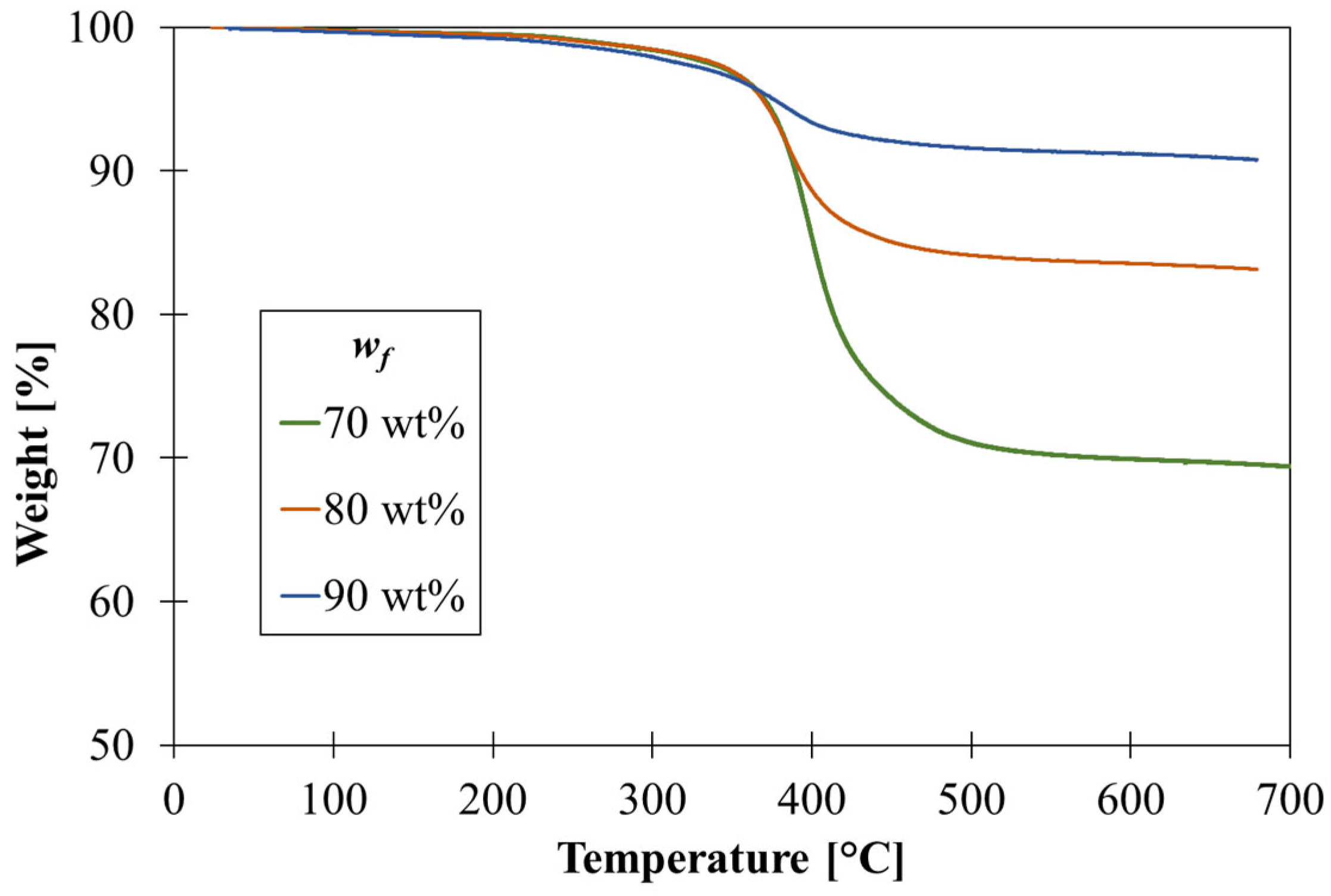

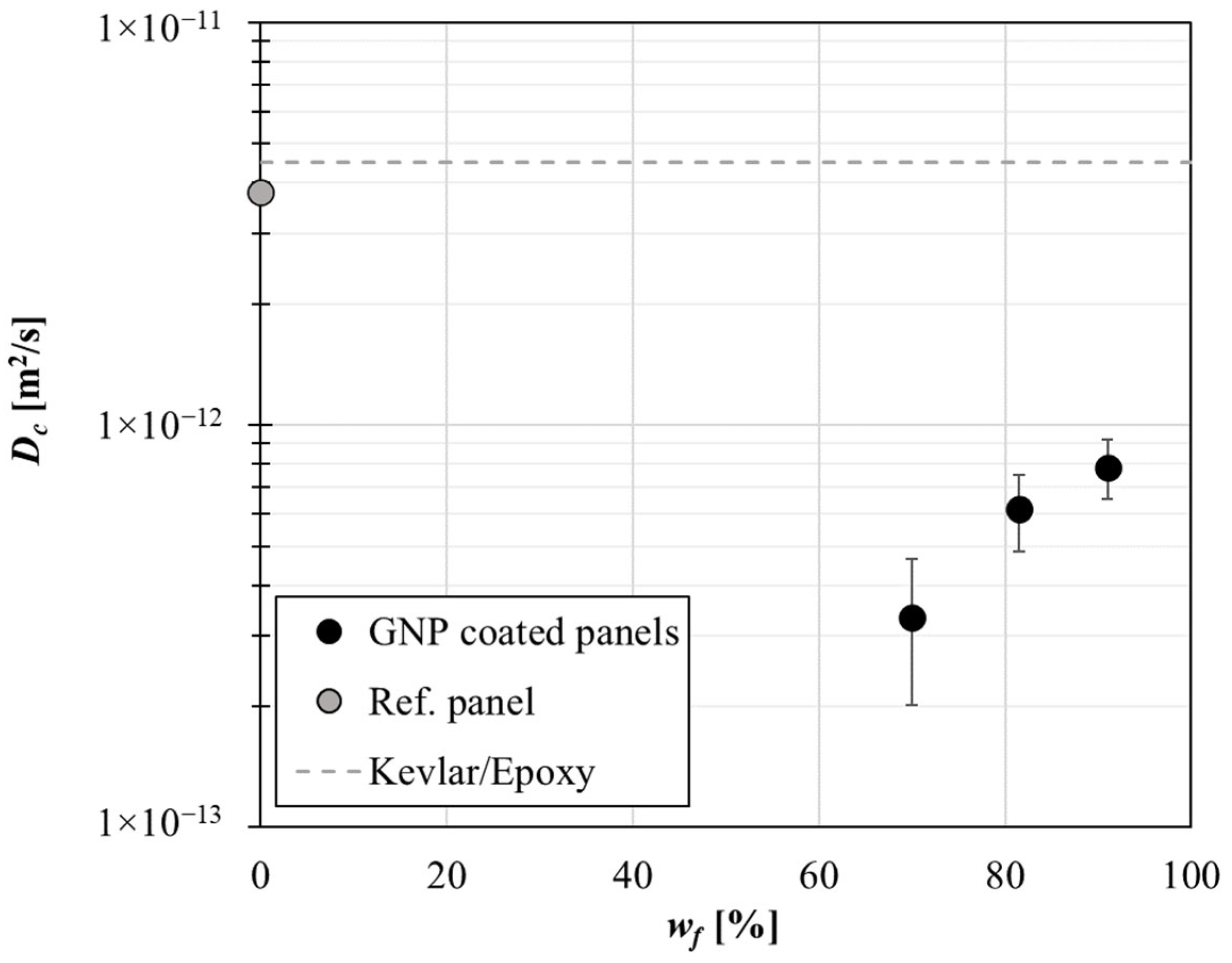
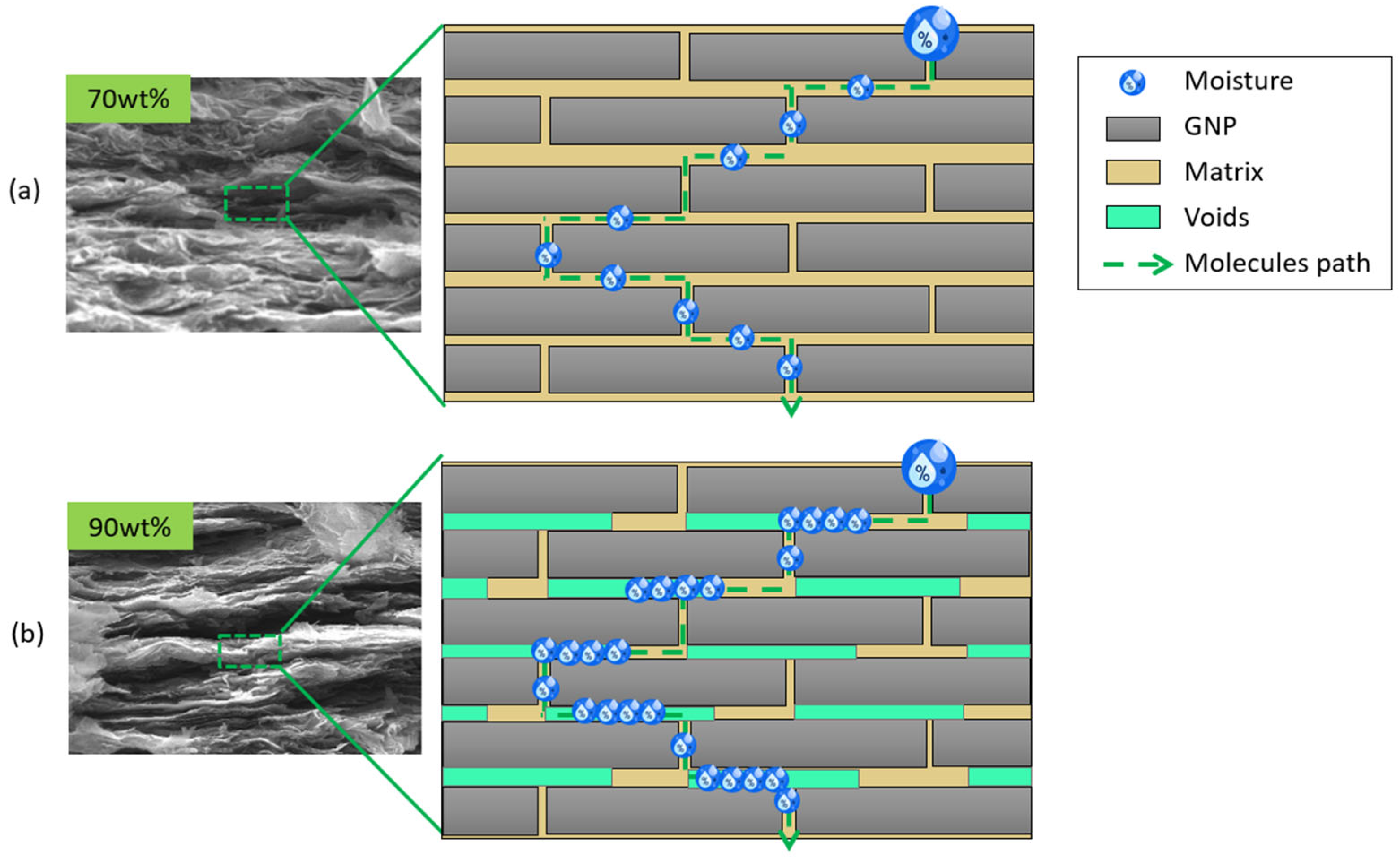


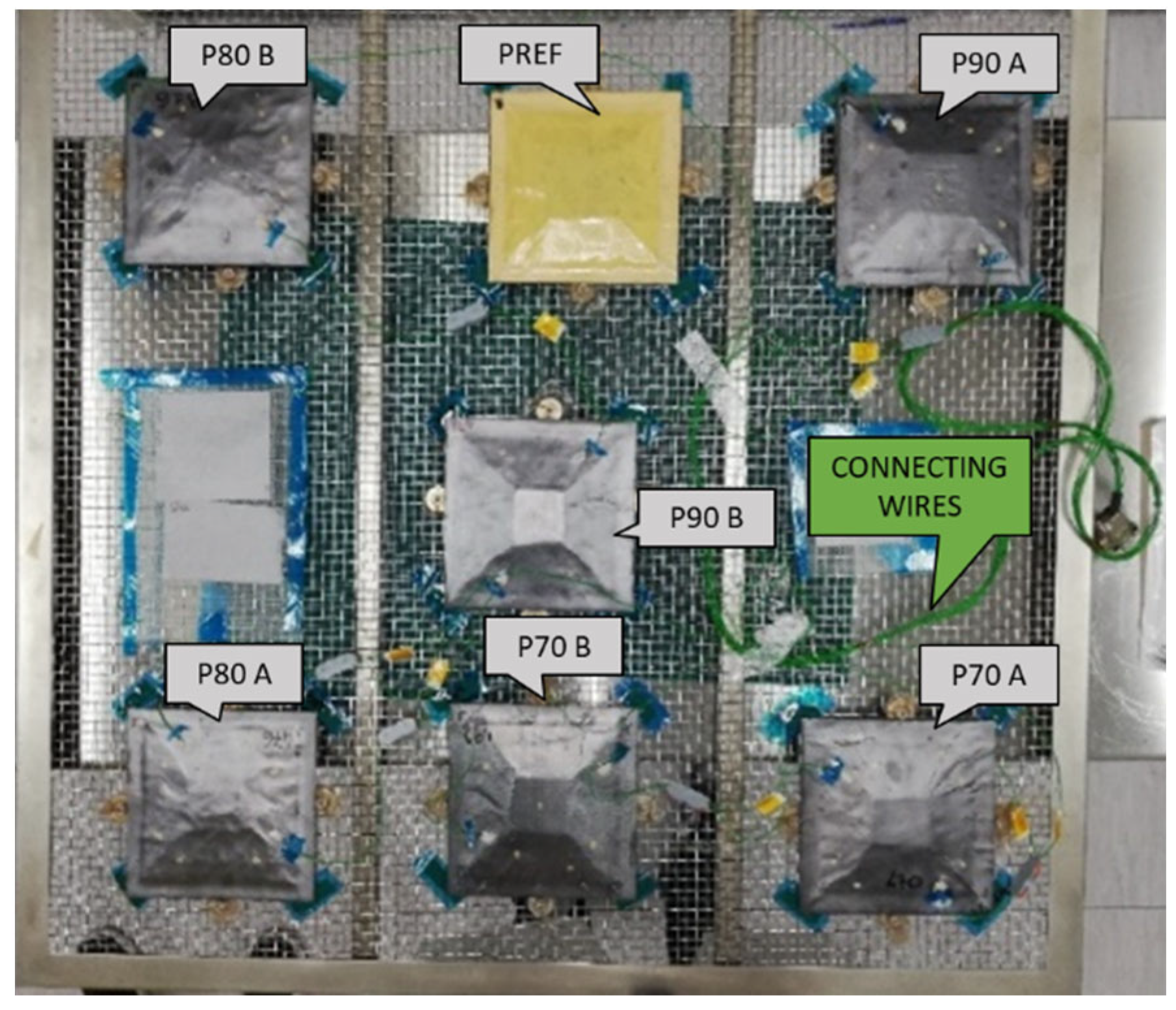
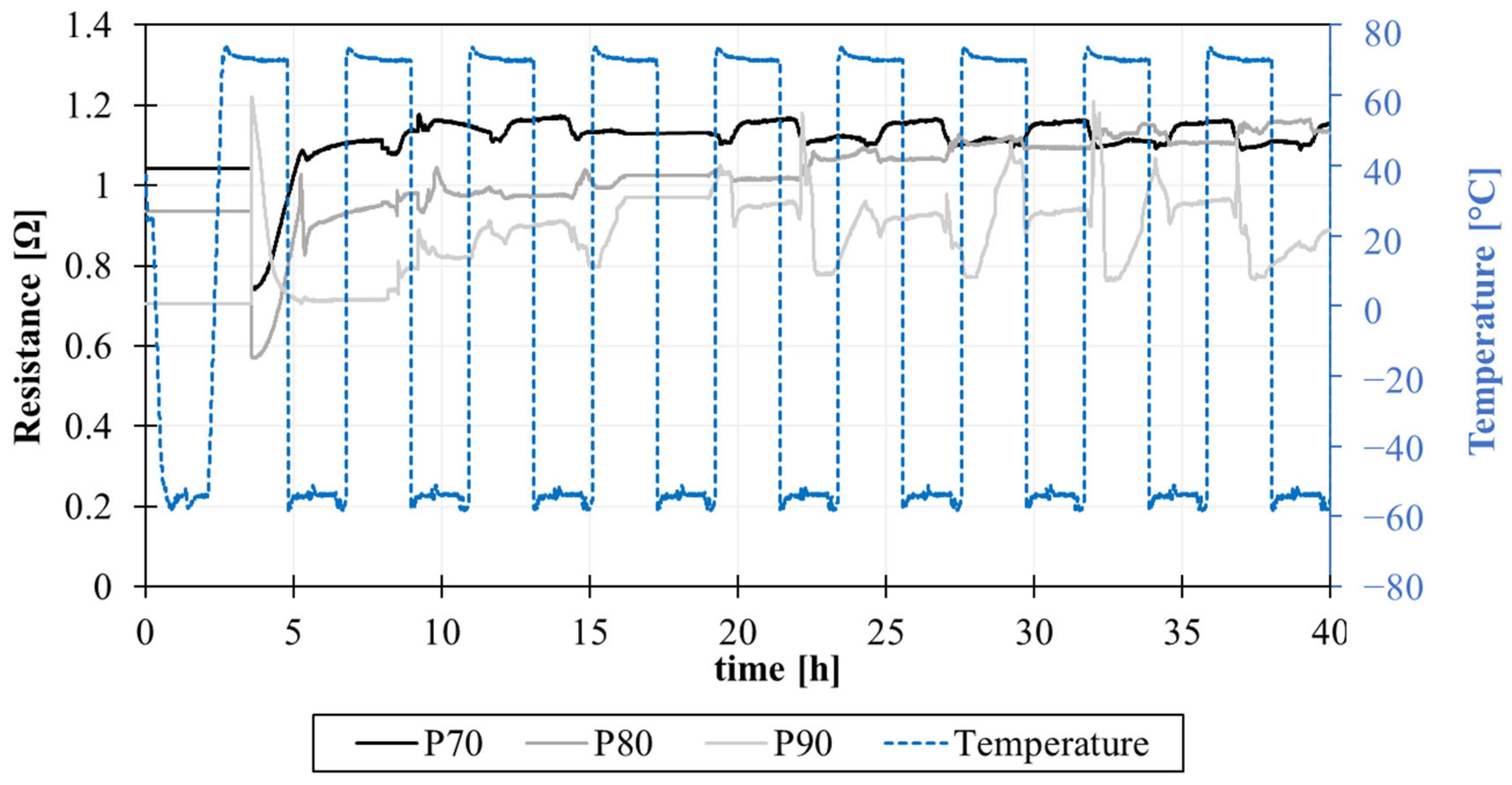

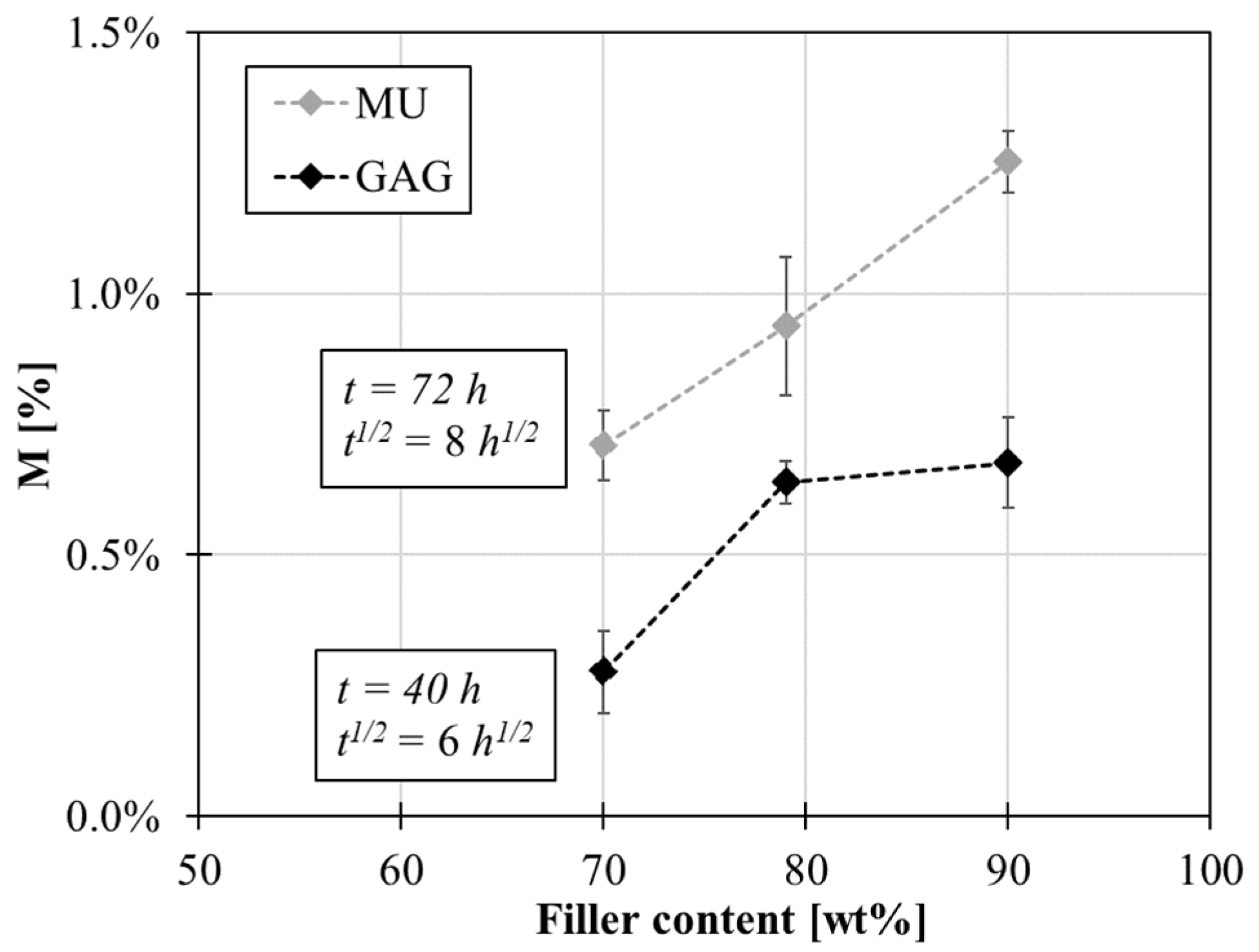
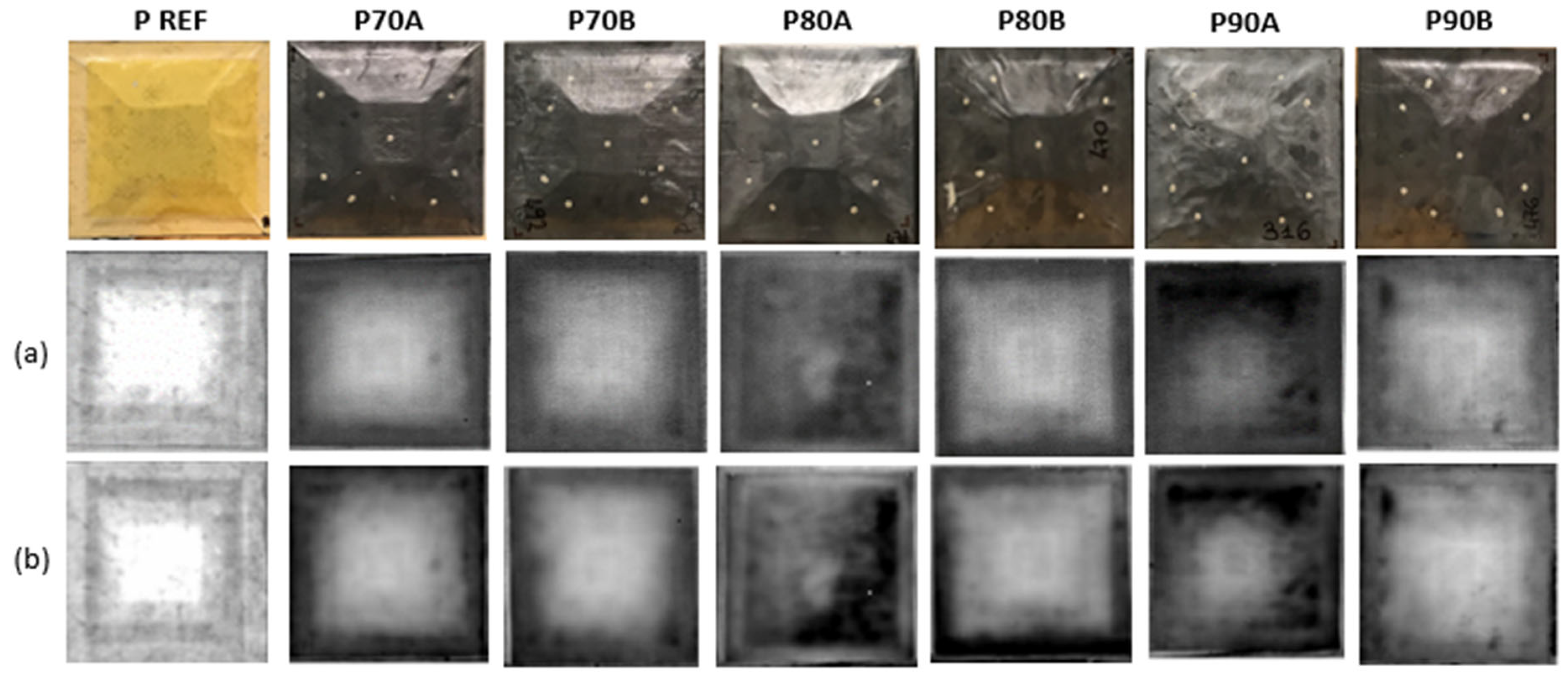
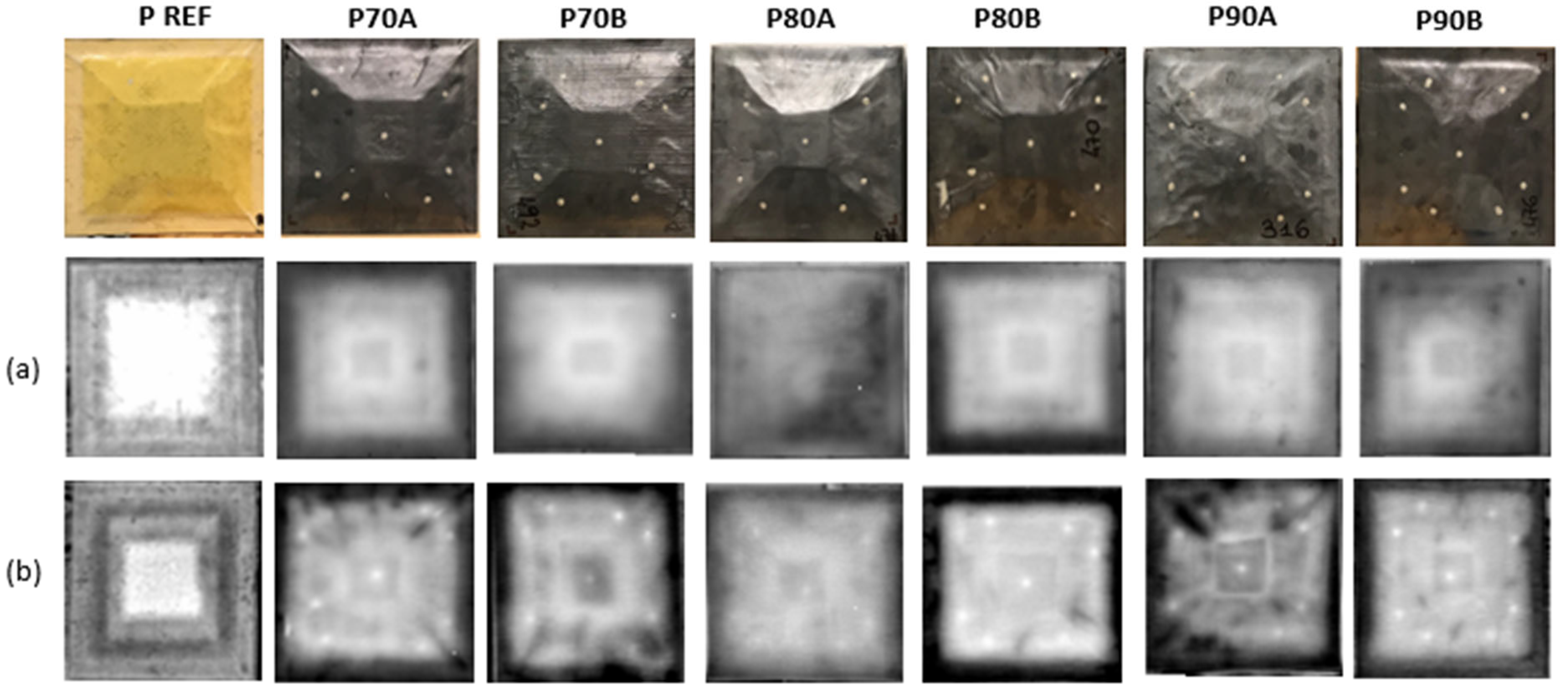
| Panel ID | Description |
|---|---|
| P-REF | No coating |
| P70-A; P70-B | 70 wt% GNP coating |
| P80-A; P80-B | 80 wt% GNP coating |
| P90-A; P90-B | 90 wt% GNP coating |
| Weight | Time (Days) | Time (Hours) |
|---|---|---|
| W0 | 0 | 0 |
| W1 | 3 | 72 |
| W2 | 6 | 144 |
| W3 | 13 | 312 |
| W4 | 20 | 480 |
| W5 | 27 | 648 |
| W6 | 34 | 816 |
| W7 | 41 | 984 |
| wf,nominal [wt%] | Ri [wt%] | wf,real [wt%] |
|---|---|---|
| 70 | 72 | 69 |
| 80 | 86 | 84 |
| 90 | 91 | 90 |
| Filler Content [wt%] | Resistance, R [Ω] | Width, w [mm] | Length, L [mm] | Thickness, t [µm] | Resistivity, ρ [Ωm] |
|---|---|---|---|---|---|
| 80 | 4.70 | 10 | 55 | 72 | 8.54 × 10−5 |
| 85 | 3.49 | 11 | 57 | 71 | 6.75 × 10−5 |
| 90 | 1.82 | 16 | 40 | 73 | 4.96 × 10−5 |
| Panel ID | wf,real [%] | M @ 41 Days [%] | ΔM/ΔMmax @ 3 Days [-] | D [m2/s] |
|---|---|---|---|---|
| P REF | - | 3.4 ± 0.11 | 0.55 | 3.8 × 10−12 |
| P70 A | 70 | 2.2 ± 0.07 | 0.16 | 3.0 × 10−13 |
| P70 B | 70 | 2.3 ± 0.05 | 0.17 | 3.7 × 10−13 |
| P80 A | 77 | 2.7 ± 0.13 | 0.21 | 5.2 × 10−13 |
| P80 B | 86 | 2.7 ± 0.09 | 0.24 | 7.2 × 10−13 |
| P90 A | 91 | 2.9 ± 0.06 | 0.25 | 7.7 × 10−13 |
| P90 B | 91 | 3.0 ± 0.08 | 0.26 | 8.0 × 10−13 |
| ID | η (t = 3 Days) | η (t = 41 Days) |
|---|---|---|
| P70 A | −82 ± 3% | −35% ± 4% |
| P70 B | −79% ± 2% | −32% ± 6% |
| P80 A | −71% ± 4% | −21% ± 2% |
| P80 B | −65% ± 3% | −20% ± 2% |
| P90 A | −61% ± 4% | −14% ± 5% |
| P90 B | −61% ± 5% | −14% ± 3% |
| wf,real [wt%] | vf [vol%] | τ [-] |
|---|---|---|
| 68.8 | 52.2 | 560.3 |
| 84.4 | 72.8 | 781.3 |
| 90.0 | 81.6 | 875.6 |
| Panel ID | M @ Cycle 1 [%] | M @ Cycle 10 [%] |
|---|---|---|
| P REF | 0.59 ± 0.05 | 1.81 ± 0.08 |
| P70 | 0.07 ± 0.01 | 0.28 ± 0.08 |
| P80 | 0.18 ± 0.03 | 0.64 ± 0.04 |
| P90 | 0.17 ± 0.06 | 0.68 ± 0.09 |
Disclaimer/Publisher’s Note: The statements, opinions and data contained in all publications are solely those of the individual author(s) and contributor(s) and not of MDPI and/or the editor(s). MDPI and/or the editor(s) disclaim responsibility for any injury to people or property resulting from any ideas, methods, instructions or products referred to in the content. |
© 2023 by the authors. Licensee MDPI, Basel, Switzerland. This article is an open access article distributed under the terms and conditions of the Creative Commons Attribution (CC BY) license (https://creativecommons.org/licenses/by/4.0/).
Share and Cite
Cilento, F.; Palmieri, B.; Giusto, G.; Volponi, R.; Bruno, G.; Tartaglia, C.C.; Toscano, C.; Giordano, M.; Martone, A. Graphite Nanoplatelets Nanostructured Films as Multifunctional Protective Layer in Kevlar/Nomex Sandwich Composites. Appl. Sci. 2023, 13, 12812. https://doi.org/10.3390/app132312812
Cilento F, Palmieri B, Giusto G, Volponi R, Bruno G, Tartaglia CC, Toscano C, Giordano M, Martone A. Graphite Nanoplatelets Nanostructured Films as Multifunctional Protective Layer in Kevlar/Nomex Sandwich Composites. Applied Sciences. 2023; 13(23):12812. https://doi.org/10.3390/app132312812
Chicago/Turabian StyleCilento, Fabrizia, Barbara Palmieri, Giovangiuseppe Giusto, Ruggiero Volponi, Giovanni Bruno, Carmine Carandente Tartaglia, Cinzia Toscano, Michele Giordano, and Alfonso Martone. 2023. "Graphite Nanoplatelets Nanostructured Films as Multifunctional Protective Layer in Kevlar/Nomex Sandwich Composites" Applied Sciences 13, no. 23: 12812. https://doi.org/10.3390/app132312812








